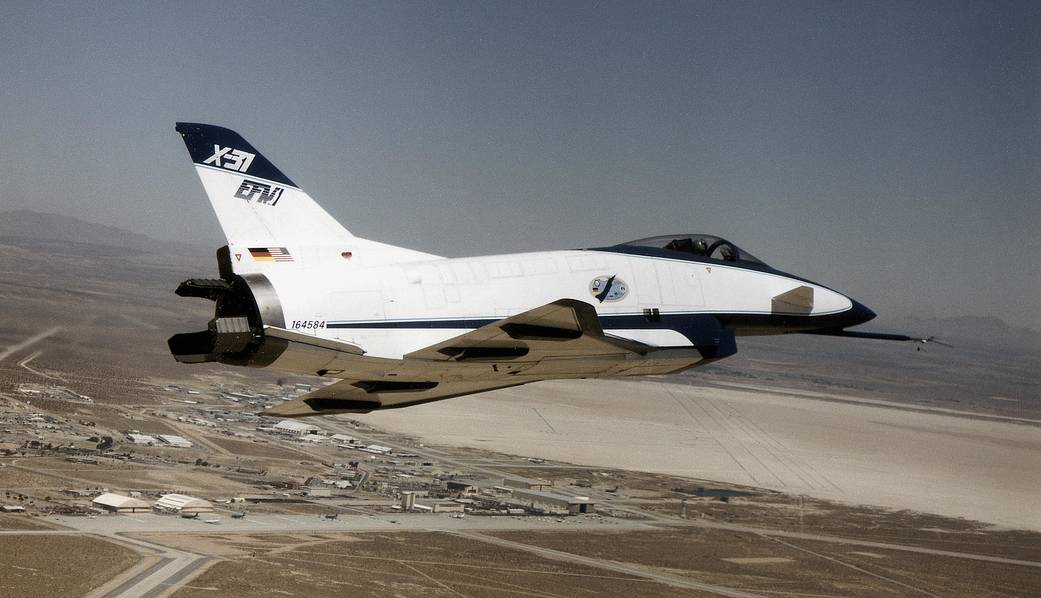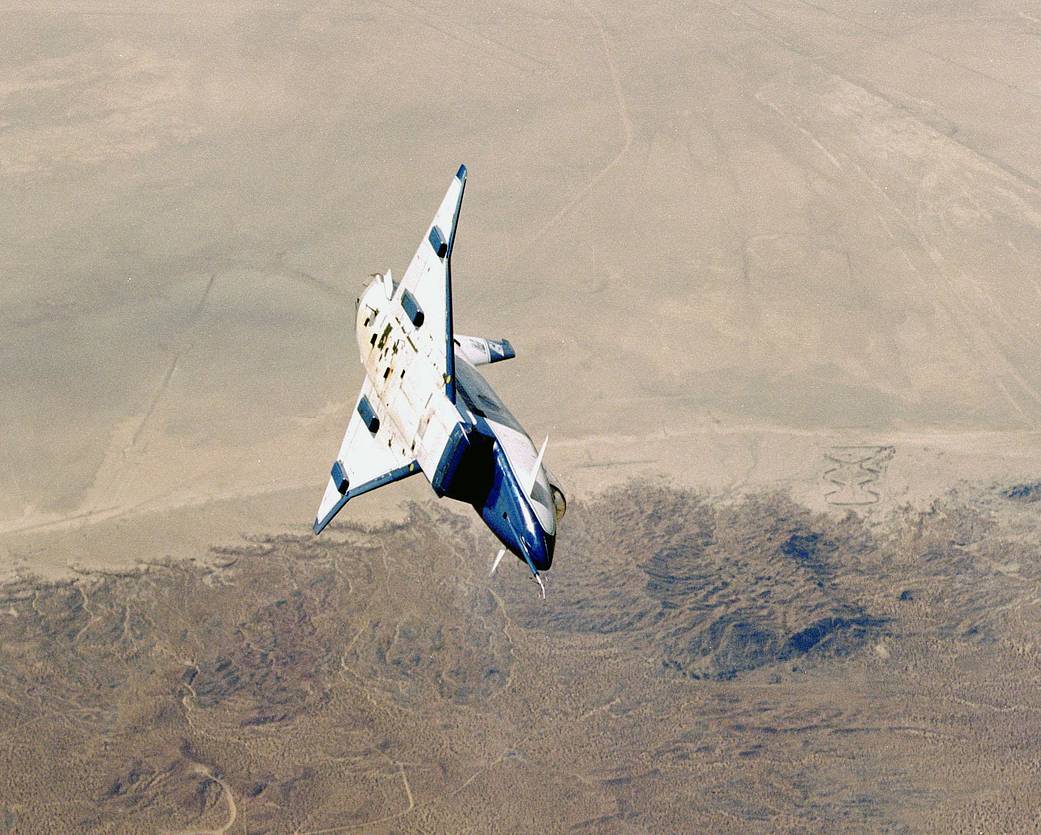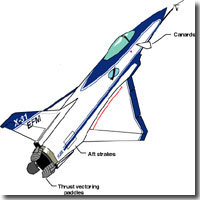
Two X-31 Enhanced Fighter Maneuverability demonstrators were test-flown during the early 1990s at NASA’s Dryden Flight Research Center, Edwards, CA, to obtain data on control in the post-stall flight regime. The X-31 program demonstrated the value of thrust vectoring – directing engine exhaust flow – coupled with advanced flight control systems, to provide controlled flight at very high angles of attack.
Background
Angle of attack – AOA or alpha – describes the angle of an aircraft’s wings relative to the oncoming wind direction, or the path of the aircraft’s flight. In the X-31, the maximum angle of attack at which airflow could be maintained over the wings in normal flight was 30 degrees nose-up from the aircraft’s direction of flight, beyond which the aircraft would stall. Flying in the post-stall regime – flying at angles of attack greater than the maximum – was achieved in the X-31 when thrust vectoring was combined with advanced digital flight controls.
Three thrust-vectoring paddles mounted on the X-31’s airframe adjacent to the engine exhaust nozzle directed the exhaust flow to provide control in pitch and yaw. Made of carbon-carbon, the paddles could sustain temperatures of up to 1,500 degrees C for extended periods. In addition the X-31s were configured with movable forward canards and eventually with fixed aft strakes. Both supplied additional pitch control in tight maneuvering situations.
The X-31 research project produced technical data at high angles of attack. This information gave engineers and aircraft designers a better understanding of aerodynamics, effectiveness of flight controls and thrust vectoring, and airflow phenomena at high angles of attack.
Flight Test Summary
During the program’s initial phase of operations at Rockwell International’s Palmdale facility, pilots flew the aircraft on 108 test missions. They achieved thrust vectoring in flight and expanded the post-stall envelope to 40 degrees angle of attack before flight operations were moved to NASA Dryden in February 1992 at the request of the Defense Advanced Research Projects Agency.
The aircraft exhibited low tolerance for sideslip, which became more pronounced as angle of attack increased. Because of difficulty gathering accurate data at high AOA, the X-31 team incorporated an unusual nose boom called a Kiel probe to calculate airflow. The Kiel probe was bent 10 degrees downward from the standard nose boom pitot configuration for more accurate data yield at higher AOA.
At Dryden an international team of pilots and engineers pitted the X-31 against comparable but non-thrust-vectored aircraft to evaluate the maneuverability of the X-31 in simulated air combat. The test team included NASA, the U.S. Navy, the U.S. Air Force, Rockwell Aerospace, the Federal Republic of Germany, and Daimler-Benz (formerly Messerschmitt-Bolkow-Blohm and Deutsche Aerospace). The X-31s outperformed other aircraft lacking thrust vectoring through use of post-stall maneuvers, and achieved a potential kill ratio of 30 to 1.
The second X-31 achieved controlled flight at 70 degrees angle of attack at Dryden on Nov. 6, 1992. That same day, it performed a controlled roll around the aircraft’s velocity vector at 70 degrees angle of attack.
On April 29, 1993, the second X-31 successfully executed a minimum radius, 180-degree turn using a post-stall maneuver, flying well beyond the aerodynamic limits of any conventional aircraft. The revolutionary maneuver has been dubbed the “Herbst Maneuver,” for Wolfgang Herbst, a German proponent of using post-stall flight in air-to-air combat.
The first X-31 aircraft was lost in an accident Jan. 19, 1995. The pilot, Karl Heinz-Lang, ejected safely before the aircraft crashed in the desert just north of Edwards. Investigation indicated the crash resulted from ice accretion in the nose boom, which was not heated. The ice accumulation reduced the internal diameter of the data probe, which in turn led to incorrect data reaching flight computers. The result was an uncontrollable aircraft. Following the pilot’s ejection, the X-31’s flight computers fought to regain control of the aircraft, which alternated between erratic and momentarily controlled flight until it struck the ground.

The X-31 program logged an X-plane record of 580 flights, 559 research missions and 21 demonstration flights at the 1995 Paris Air Show, where its performance wowed the crowds. The X-31 project was the first international experimental aircraft development program administered by a U.S government agency.
Following the X-31 program’s conclusion in June 1995, the surviving aircraft was transferred to the U.S. Navy Test Pilot School at the Patuxent River Naval Air Station in Maryland for additional research. After that follow-on program, the aircraft was transferred to Germany where it was placed on display.
Aircraft Specifications
The X-31 had a wingspan of 23.83 feet and a fuselage length of 43.33 feet. It was powered by a single General Electric F404-GE-400 turbofan engine that produced 16,000 pounds of thrust in afterburner. Typical takeoff weight of the X-31 was 16,100 pounds including 4,100 pounds of fuel.
The X-31 design speed was Mach 0.9 with an altitude capability of 40,000 feet. For specific tests to determine thrust vectoring effectiveness at supersonic speeds the aircraft was flown to Mach 1.28 at an altitude of 35,000 feet.































